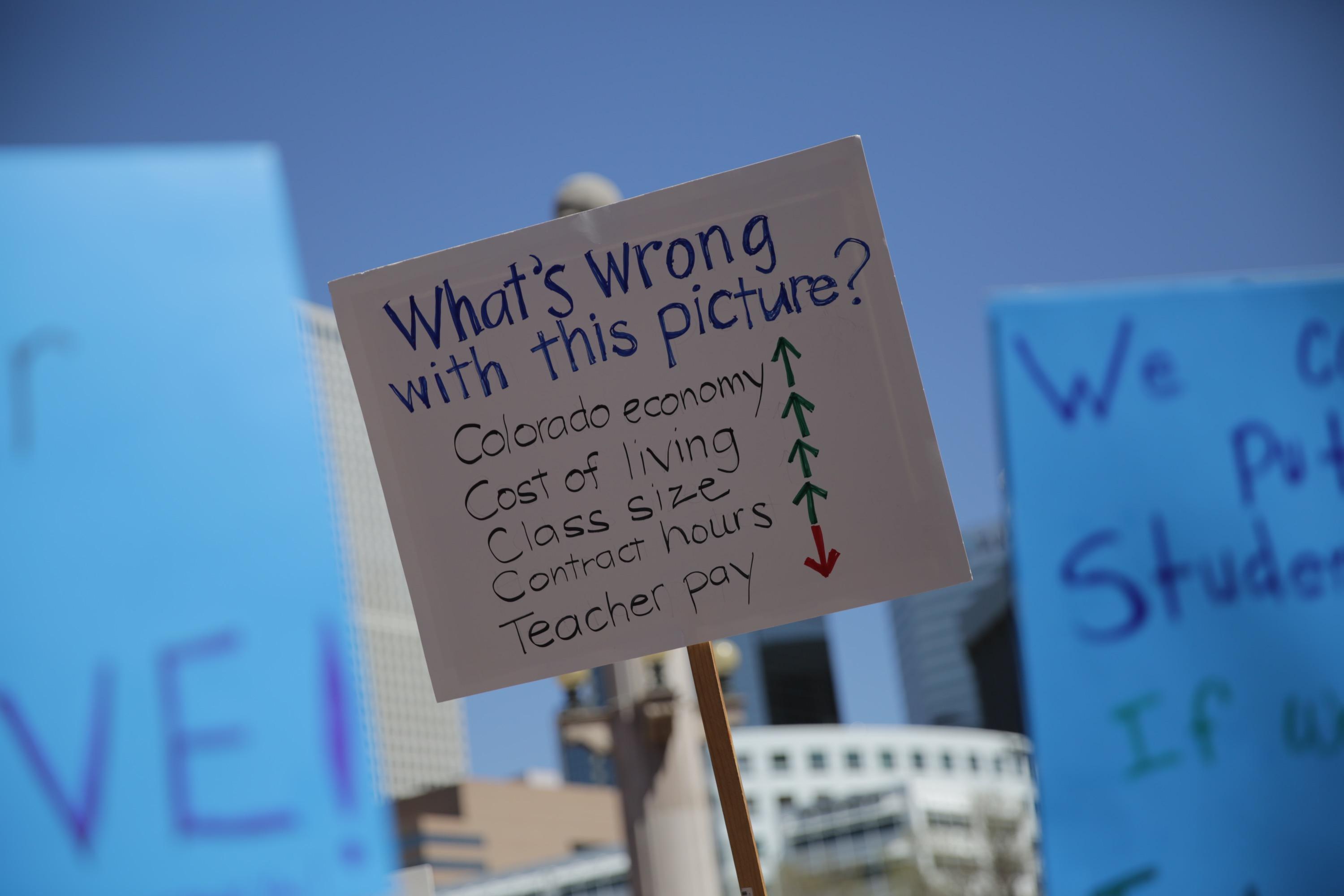

This story is part of Colorado Wonders, where you ask us about what's on your mind about the Centennial State, and we find the answers. Ask us your question here.
Today, we hear from 18-year-old Grant Gulevich:

Did the spring protests by Colorado teachers result in any action on their concerns about school funding and retirement funds?
On the teacher’s retirement fund, PERA: Lawmakers took action, but it wasn’t what teachers wanted. After much skirmishing, lawmakers decided that changes needed to be made to make sure there would be enough money in PERA for future retirees. Teachers have to now contribute an extra two percent of their pay into PERA. Legislators also raised the retirement age for new teachers from 58 to 64.
On the issue of teacher pay: The largest teachers’ union, the Colorado Education Association, believes the protests did allow teachers to share their stories with the public, pushed several districts to reach agreements for pay raises and spurred teachers to gather signatures for a ballot measure to raise money for public schools.
On the issue of school funding: Lawmakers bumped up per pupil funding about $475 to account for inflation and growth. In addition, they added $150 million more for education, which chips away a bit at the amount owed to schools from cuts made during the recession a decade ago. That extra money helped some districts give teachers raises but it’s a small dent in paying back the money owed to schools.
Grant Gulevich: What is the state’s I.O.U to public schools?
An I.O.U. is a simple way to think of a large amount of money state lawmakers owe to public schools. Colorado owes money because the state constitution requires a certain level of funding every year, but lawmakers took billions during the recession to pay for other areas of the budget that were strapped, like prisons and Medicaid.
They've kept borrowing from the school budget, it's up to $7.4 billion. That means about $800 million each year. And they've started paying it back in increments — like $150 million this year — but haven't really made a big dent schools want to see in the amount owed. This chart shows how much money each school district has lost since the recession.
Grant Gulevich: If there is another recession, could the I.O.U. get larger and is there a plan to pay it back?
Yes, if there is a recession, the I.O.U. to public schools could get larger. In good economic times, it has been difficult to pay back money owed to schools because an element of Colorado’s Taxpayer Bill of Rights says that any money the state raises above TABOR revenue caps, must be returned to taxpayers in the form of rebates.
Ninety-five percent of the district’s superintendents decided to approach lawmakers in February with a unified long-term funding plan to eliminate the yearly shortfall. It called for bringing K-12 students up to the national average in per student funding, funding full-day Kindergarten, and overhauling the way schools are funded. It would have required going to voters to fund it. But the plan didn’t gain enough support to pass in the legislature.
And there's no other set plan to restore all that money to schools, although there is a legislative school interim committee looking into funding solutions.
Grant Gulevich: What are school districts options if they do not succeed in getting more money?
School districts are pinning their hopes on Amendment 73 on the November ballot which would raise $1.6 billion for schools. Voters have turned down the last two statewide school ballot measures. Some districts also have local property tax and school bond proposals on ballots.
If those don’t pass, districts say they will continue to do what they have done for the past decade. Class sizes will be larger, elective programs like art, music, P.E., vocational and computer classes, foreign languages – anything that is not tested by the state will be vulnerable to cuts. Building repairs will continue to be pushed aside and bus routes cut.
Perhaps the biggest impact will school districts will continue to have a challenging time recruiting and keeping teachers because they can’t raise salaries. Colorado teachers are paid below the national average and teachers in rural Colorado are paid dramatically lower. There won’t be enough money for enough full time social workers and child psychologists and counselors that schools say they need. The majority of districts in Colorado have four-day school weeks. Pressure will build for more to do the same thing to save money and attract teachers when they can’t pay them more.
Grant Gulevich: Why do teachers in Colorado get paid so differently when they all have similar teaching credentials?
The average salary range is quite wide in Colorado. Average salaries run between roughly $29,000 and $75,000. Many states have what is called a statewide salary schedule. Everybody plays by similar rules and the schedules dictate minimum salaries that teachers must earn based on years of education and years in the classroom. This is to ensure that teachers make a living wage no matter where in the state they live.
Colorado is different, known as a “local control “state. That means local school districts make the decisions about curriculum and how much teachers are paid.
One reason there is inequity in pay is because voters in some districts have approved local property tax increases known as mill levy overrides. Those have enabled districts to keep salaries higher, though districts would argue there still isn’t enough money to give teachers a living wage. Voters in other districts haven’t raised as much in property taxes so teachers aren’t paid as much. Rural Colorado, with high poverty rates, is suffering from severe teacher shortages because of low pay.







